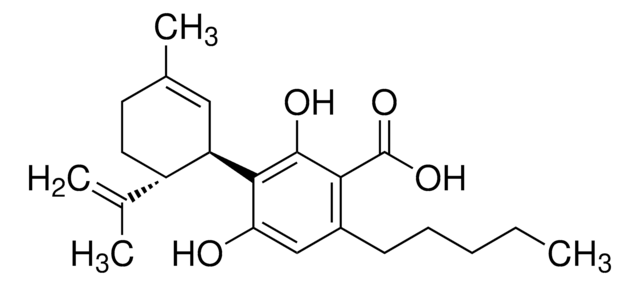Wichtige Dokumente
T2386
Δ9-Tetrahydrocannabinol -Lösung
ethanol solution
Synonym(e):
Δ1-Tetrahydrocannabinol
About This Item
Empfohlene Produkte
Form
ethanol solution
Qualitätsniveau
Arzneimittelkontrolle
USDEA Schedule I; Home Office Schedule 2; stupéfiant (France); kontrollierte Droge in Deutschland; regulated under CDSA - not available from Sigma-Aldrich Canada; psicótropo (Spain); Decreto Lei 15/93: Tabela IIB (Portugal)
Konzentration
25 mg/mL (+/- 5%)
Lagertemp.
−20°C
SMILES String
[H][C@@]12CCC(C)=C[C@@]1([H])c3c(O)cc(CCCCC)cc3OC2(C)C
InChI
1S/C21H30O2/c1-5-6-7-8-15-12-18(22)20-16-11-14(2)9-10-17(16)21(3,4)23-19(20)13-15/h11-13,16-17,22H,5-10H2,1-4H3/t16-,17-/m1/s1
InChIKey
CYQFCXCEBYINGO-IAGOWNOFSA-N
Angaben zum Gen
human ... CNR1(1268) , CNR2(1269)
mouse ... Cnr1(12801)
rat ... Cnr1(25248)
Suchen Sie nach ähnlichen Produkten? Aufrufen Leitfaden zum Produktvergleich
Verwandte Kategorien
Anwendung
Biochem./physiol. Wirkung
Leistungsmerkmale und Vorteile
Angaben zur Herstellung
Signalwort
Danger
H-Sätze
Gefahreneinstufungen
Eye Irrit. 2 - Flam. Liq. 2
Lagerklassenschlüssel
3 - Flammable liquids
WGK
WGK 2
Flammpunkt (°F)
57.2 °F
Flammpunkt (°C)
14 °C
Persönliche Schutzausrüstung
Eyeshields, Faceshields, Gloves, type ABEK (EN14387) respirator filter
Analysenzertifikate (COA)
Suchen Sie nach Analysenzertifikate (COA), indem Sie die Lot-/Chargennummer des Produkts eingeben. Lot- und Chargennummern sind auf dem Produktetikett hinter den Wörtern ‘Lot’ oder ‘Batch’ (Lot oder Charge) zu finden.
Besitzen Sie dieses Produkt bereits?
In der Dokumentenbibliothek finden Sie die Dokumentation zu den Produkten, die Sie kürzlich erworben haben.
Kunden haben sich ebenfalls angesehen
Unser Team von Wissenschaftlern verfügt über Erfahrung in allen Forschungsbereichen einschließlich Life Science, Materialwissenschaften, chemischer Synthese, Chromatographie, Analytik und vielen mehr..
Setzen Sie sich mit dem technischen Dienst in Verbindung.







